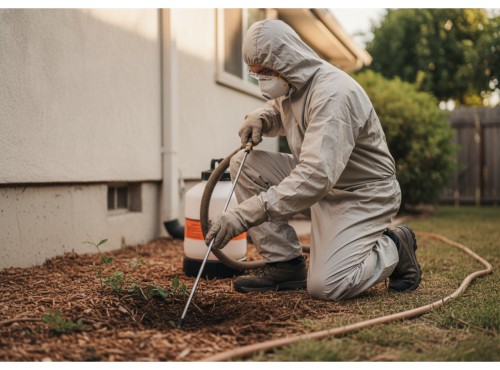Recognizing Structural Warning Signs
Early identification is vital in preventing major damage. Termite infestations often begin unnoticed, as visible indicators resemble moisture or age-related deterioration. Licensed Pest Management Professionals (PMPs) across the Greater Toronto Area emphasize the importance of recognizing subtle visual clues that differentiate termite activity from other wood-damaging factors such as carpenter ants or fungal decay.
Common signs include:
- Mud tubes ascending along foundation walls, bulkheads, or concrete footings.
- Frass (fine wood particles) collecting near baseboards, window sills, or corners.
- Hollow-sounding wood when tapped, indicating internal gallery formation.
- Detached wings from swarmers (alates) near windows or light fixtures during spring.
- Sagging floors or bubbled paint, especially in basements and laundry rooms.
Reports from properties near Leslieville and the Don Valley Trails frequently document these warning signs. These districts, with their mature trees and high soil moisture, often present ideal microhabitats for termite foraging.
Inspection and Diagnostic Protocols
Professional termite control in Toronto begins with a comprehensive site assessment, integrating both physical inspection and technological monitoring. Certified PMPs conduct moisture readings, crack and gap surveys, and visual inspections to locate structural voids or harborage sites.
Inspections typically target:
- Foundation walls and basement bulkheads
- Wooden support beams and sill plates
- Crawl spaces and attic entry points
- Utility penetrations and drain lines
- Soil contact points near decks and garden beds
Advanced inspection equipment such as infrared imaging cameras, acoustic emission detectors, and moisture meters are often used to locate concealed activity. These tools identify areas of thermal variation or hollow resonance, signaling the presence of hidden galleries.
In high-risk neighborhoods such as Spadina Avenue and College Street, termite inspections often reveal consistent activity along older sub-slab foundations, where cracks or unsealed joints act as ingress points.
Treatment and Integrated Control Measures
Once an infestation is confirmed, licensed professionals employ Integrated Pest Management (IPM) protocols designed to eliminate colonies while minimizing risk to occupants and the environment.
Key treatment strategies include:
| Treatment Method |
Description |
Compliance Reference |
| Trenching and Sub-Slab Injection |
Establishes a continuous soil barrier using approved termiticides. |
Health Canada PCP, Label is the Law |
| In-Ground Baiting System |
Utilizes slow-acting, non-repellent termiticides in bait stations around the perimeter. |
NPMA Standards, CPMA IPM Guidelines |
| Localized Treatment |
Targets isolated infestation zones within wall voids or flooring systems. |
WHMIS, REI Compliance |
| Moisture Management |
Reduces humidity and prevents conducive conditions through drainage and ventilation adjustments. |
MNRF Structural Protection Guidelines |
Modern treatments frequently use microencapsulated formulations (ME) or biorational pesticides, which are designed for controlled release and environmental safety. These formulations provide long-lasting residual protection while maintaining compliance under Health Canada’s Pest Control Products Act (PCPA).









